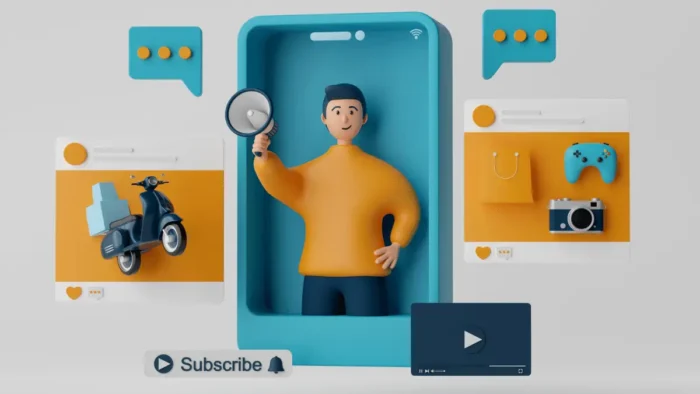Growing sales for your ecommerce business might seem like an uphill battle; however, many proven strategies can facilitate excessive growth and support what you do to help you reap the rewards of your effort.
While it’s true that the economy’s rapid growth has led to saturation in many sectors, it doesn’t mean there’s no room for your e-commerce business. With over 2.5 billion online shoppers and a multitude of strategies at your disposal, there’s ample opportunity to establish your unique presence.
Despite over 25 million ecommerce stores, there are also over 2.5 billion online shoppers, meaning there is always room for new businesses to establish themselves amongst their peers.
Whether you’re starting out, wanting to change your fortunes, or pursuing growth in the next few years, these tips can be instrumental in helping you propel your ecommerce store forward and achieve your goals.
Marketing Is Key
You know this, everyone knows this, but marketing your ecommerce stores is vital for your ongoing success. But what is the best way to market yourself and ensure that people keep coming back time and time again?
Understanding your audience’s needs is crucial for effective marketing. By using data from your ideal customer, you can steer your ecommerce venture in the right direction, ensuring your strategies and content align with their preferences.
You need a mix of passive and active marketing methods that all work together to drive results. Active ecommerce marketing includes networking via your social media accounts, talking to followers, engaging with them and ensuring that you build a good relationship and community; current trends lead towards creating a group from your social media page on Facebook to allow followers to engage with you and each other share purchases and discuss what they would like to see from you. From here, they can invite more people to the group, cementing your audience further. Other active marketing options to consider include calls to action on your website or communications, email newsletters or blast campaigns, as well as Google ads that thrust your website to the top of search engine results relating to your search terms and the ever-successful creation of viral social media content pertaining to your brand.
Passive marketing, on the other hand, is marketing that naturally draws people to your business. This can be via radio ads that people tune out in the background, an effective SEO campaign, social media ads that appear as a native post in their feed, or ascending out branded items, e.g., putting your logo on clothing you sell or give away for free.
User Generated Content
User-generated content, or UGC, is becoming an absolute powerhouse as a marketing method and is an effective way to boost sales and build authority and a good reputation. Essentially, you’re using reviews or content created by customers to promote your brand. This content can be used with with permission to show real-life examples of your products or services so people can see how it might work for them. The vacuum brand Shark uses a lot of user-generated content to push their products, as seeing people using them in real scenarios can further support their marketing message, which then supports the thought that they have superior products and that you need them in your life. The more amazing people make them seem, the greater the demand.
User-generated content is a powerful tool in building trust. In fact, 70% of teens trust UGC over content brands put out about products. By showcasing real-life examples of your products or services, you’re not just promoting your brand, you’re building a community of satisfied customers who can vouch for your quality.
However, you need to be clever about the type of content you use. Older generations will prefer to be targeted by emails, so using reviews and testimonials might work better for this age group. At the same time, short content or videos will be best for attracting younger customers. Know your audience and tailor the type of UGC you use to get the best results.
Low Effort Experience
A low-effort customer experience, or self-service customer experience, is gaining popularity. Over 80% of consumers now prefer self-serve options in ecommerce. This trend underscores the importance of making the purchasing process as effortless as possible for your customers.
Essentially, effort or self-serve ecommerce stores are stores that take care of everything for the customer, so they don’t have to do much aside from choosing what they want and making the purchase. It involves a range of ways to contact you as a company, such as live chats, social media messaging, email, call centres, and so on. It means having a knowledge base on your website so they can look for the answers to questions themselves. It has all the information someone needs to make a purchase set out clearly, concisely, and in an easy-to-find way.
Basically, the less they have to do, the better. So using the services of chatbot company click4assistance to enable a chatbot can help you to help customers serve themselves instead of contacting you and waiting for an answer; having staff or chatbots enabled for your social media accounts for queries coming this way, redesigning your website to make navigation easier, adding in FAQs, troubleshooting guides and tutorials will all help you improve the usability of your ecommerce stores ad work towards a more self-service experience for customers.
Use Your Data
According to McKinsey enterprises are 23 times more likely to acquire new customers and 6 items more likely to retain existing customers thanks to making data driven results. Partner this with the fact that 80% of people leave a website due to a poor or less personalised experience, and it’s not hard to see the importance of collecting and using the data you have access to.
And it’s estimated that many companies are unaware of 80% of the data they hold or are unable to use it for various reasons.
Data can allow you to see trends in buying patterns, the demographic of your customer base and their entire history with you, as well as what will put them off, entice them in or leave them sitting on the fence. Data, when used correctly, can be your best friend. But you need to know how to use it to your advantage. You can implement software that can identify and extrapolate data for you so you can use it easily instead of doing this manually, or you can work with third parties to do this for you so you can easily get what you need.
Remember, data-driven decisions are your key to growth and success. By understanding your customer base, their preferences, and their history with your brand, you can make informed choices that will propel your business forward.
Be Willing To Learn
Aside from cash flow issues, one of the leading causes of business failure is a failure to learn or an inability to keep moving forward. Just because something has always been done one way does not mean new ways or methodologies won’t be useful to you. Nor can you know everything there is to know about what you do all the time.
An unwillingness to learn essentially puts you in a holding state as your business is operating as it is, and you are unable to use new information to move forward. Being committed to learning as much as possible can help to open you up to new ideas and ways of thinking that can benefit what you do. Whether you learn from your peers, network in your industry, take the lead from competitors or take advice from employees or even customers, adopting a learning mentality lets you make better decisions that can help you grow and expand as you need to.
Another way to learn is to use your analytics to uncover important details that can impact your sales and potential and help you avoid repeating the same mistakes.
Ask for Feedback
Feedback in any form is essential for all businesses. It is your direct way of knowing what you’re doing well, where you need to improve, and what your customers think of you. But customers aren’t the only source of feedback you can gain. You can ask peers, employees, vendors, and others about their thoughts on what you do and what they would suggest for you going forward.
Not only do you need to ask for feedback, but you also need to do something about it. If it’s positive, you should look at how you can expand this into other areas and build on what you’re already doing well. If it’s not so good, you should look at what the feedback is telling you and how you can make the required changes and remove any issues or concerns.
Once you have collected the feedback, you need to communicate how it has helped you or what changes you have made. 77% of people are willing to leave feedback when asked, but if they do not feel that feedback is being listened to, this will have the opposite effect. Take the time to give feedback to those who leave feedback and let them know how much you appreciate it, however you use it.
Improving your e-commerce store and setting yourself up for success requires you to be proactive in ensuring that you are making the right decisions regarding the details you have to hand to help you make changes and improvements that benefit both the business and the customer.





